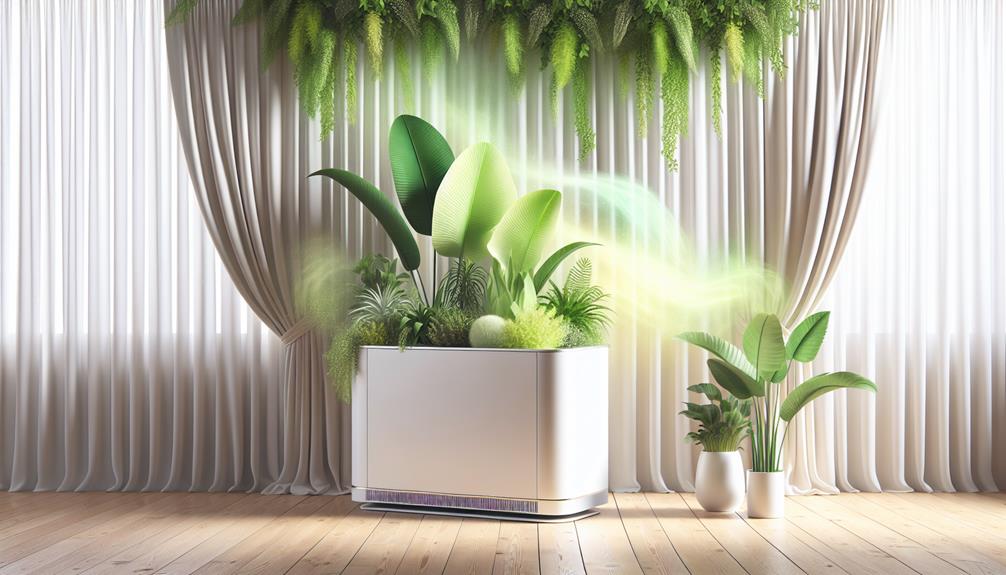In an age where indoor air pollution is a growing concern, the role of air purifiers has become increasingly crucial. These devices are designed to remove contaminants from the air we breathe, but how exactly do they achieve this?
Understanding the mechanisms behind air purifiers' functionality is key to maximizing their effectiveness. From HEPA filters to activated carbon filters, the variety of options can be overwhelming. However, choosing the right air purifier involves more than just filter types.
Considerations such as room size, noise level, and maintenance requirements all play a part in selecting the ideal device for your home or office.
Key Takeaways
- Air purifiers remove harmful particles and improve indoor air quality.
- They work by efficiently capturing and eliminating allergens and pollutants.
- Different types of filters, like HEPA and UV, provide unique benefits.
- Regular maintenance, including filter changes, ensures optimal air purification performance.
Benefits of Air Purifiers
Air purifiers offer numerous benefits for improving indoor air quality and promoting better respiratory health. By removing harmful particles like dust, pollen, pet dander, and mold spores from the air, air purifiers help create a cleaner and healthier environment for individuals and families. This is especially beneficial for those with allergies, asthma, or other respiratory conditions, as cleaner air can lead to fewer symptoms and improved overall well-being.
Additionally, air purifiers can help eliminate unpleasant odors caused by cooking, pets, or smoke, creating a more inviting and pleasant living space. This can be particularly beneficial for households where odors tend to linger, despite efforts to keep the space clean and fresh.
Furthermore, air purifiers can also trap volatile organic compounds (VOCs) emitted by household products and furnishings, reducing potential health risks associated with long-term exposure to these chemicals. By investing in an air purifier, individuals can take proactive steps towards creating a healthier and more comfortable indoor environment for themselves and their loved ones.
How Air Purifiers Work
Utilizing advanced filtration technology, air purifiers function by capturing and eliminating airborne contaminants to improve indoor air quality. These devices work diligently to create a cleaner and healthier environment for you and your loved ones.
Here are four key points to help you understand how air purifiers operate:
- Efficiency: Air purifiers efficiently remove dust, pollen, pet dander, and other pollutants from the air, ensuring a fresher and purer indoor atmosphere.
- Effectiveness: By trapping microscopic particles through filters or electronic air cleaning methods, air purifiers effectively reduce the presence of allergens and irritants in your home.
- Consistency: Operating consistently, air purifiers work around the clock to maintain clean air, providing a sense of security and comfort.
- Peace of Mind: Knowing that your air purifier is actively purifying the air gives you peace of mind, allowing you to relax and enjoy your living space to the fullest.
Types of Air Purifier Filters
With a focus on enhancing air quality within indoor environments, one crucial aspect to consider is the varying types of filters utilized in air purifiers. These filters play a vital role in capturing and eliminating airborne pollutants, allergens, and contaminants, thereby ensuring cleaner and healthier air for occupants.
There are several common types of air purifier filters available on the market today, each with its unique features and benefits.
- HEPA Filters: High-Efficiency Particulate Air (HEPA) filters are renowned for their ability to trap 99.97% of particles as small as 0.3 microns, including dust, pollen, pet dander, and mold spores.
- Activated Carbon Filters: These filters excel at removing odors, gases, and volatile organic compounds (VOCs) from the air by adsorbing them onto the porous surface of the activated carbon.
- UV Filters: Ultraviolet (UV) filters use UV-C light to kill bacteria, viruses, and other microorganisms by disrupting their DNA structure, providing an added layer of protection.
Understanding the different types of air purifier filters available can help individuals make informed decisions when selecting the most suitable option for their specific air quality needs.
Factors to Consider When Buying
When purchasing an air purifier, it is essential to carefully consider specific factors to ensure optimal performance and effectiveness. To make the best choice and create a healthier indoor environment, consider the following:
- Room Size: Determine the square footage of the room where the air purifier will be used. Choosing a purifier with the appropriate coverage for your space ensures efficient air cleaning.
- Filtration Technology: Look into different types of filtration systems such as HEPA filters, activated carbon filters, or UV-C light. Selecting the right technology based on your needs can significantly impact the air quality in your home.
- Noise Levels: Consider the noise produced by the air purifier, especially if you plan to use it in bedrooms or offices. Opt for a model with a noise level that suits your preferences for a peaceful and undisturbed environment.
- Energy Efficiency: Check the energy consumption of the air purifier to ensure it is energy-efficient. Choosing a model that is eco-friendly not only benefits the environment but also helps you save on electricity bills.
Maintenance Tips for Air Purifiers
To ensure the longevity and effectiveness of your air purifier, implementing proper maintenance practices is crucial. Regularly changing the filters is essential to keep your air purifier functioning optimally. Most manufacturers recommend replacing filters every 3 to 6 months, but this can vary based on usage and air quality.
Additionally, wiping down the exterior of the purifier with a damp cloth can help prevent dust buildup and maintain its appearance. It is also important to check for any blockages in the air intake and exhaust vents, as obstructions can hinder the purifier's performance.
Keeping your air purifier in a well-ventilated area away from walls and furniture will ensure proper airflow and efficiency. Lastly, referring to the manufacturer's instructions for specific maintenance guidelines tailored to your air purifier model is highly recommended.
Frequently Asked Questions
Can Air Purifiers Help With Reducing Allergies and Asthma Symptoms?
Reducing allergies and asthma symptoms can be achieved through various methods, including environmental control, medication, and lifestyle adjustments.
Identifying triggers, such as dust mites, pollen, or pet dander, and minimizing exposure can help alleviate symptoms.
Additionally, maintaining a clean and well-ventilated living space, practicing good hygiene, and seeking medical advice for proper treatment are crucial steps in managing these conditions effectively.
Are There Any Health Risks Associated With Using an Air Purifier?
When considering the use of any household appliance, it is important to be aware of potential health risks. In the case of air purifiers, some concerns may arise from improper maintenance, such as mold growth in filters or the release of ozone from certain types of purifiers.
Additionally, individuals with respiratory conditions should be cautious with air purifiers that produce ozone as it may exacerbate symptoms. Regular maintenance and selecting a safe, effective model can mitigate these risks.
Do Air Purifiers Eliminate All Types of Odors in the Air?
Air purifiers can vary in their ability to eliminate different types of odors in the air. While some air purifiers are specifically designed to target odors like smoke or pet smells, others may not be as effective.
For example, activated carbon filters are known to be effective in removing odors. It is essential to choose an air purifier with the right filtration system to effectively eliminate specific odors in the air.
Can Air Purifiers Help With Reducing the Spread of Viruses and Bacteria?
Air purifiers may help reduce the spread of viruses and bacteria by capturing and removing airborne particles that could potentially carry these pathogens.
While they may not eliminate all risks, air purifiers with HEPA filters can effectively trap smaller particles, including some viruses and bacteria, improving indoor air quality.
It is important to note that air purifiers should be used in conjunction with other preventive measures, such as proper ventilation and regular cleaning, for optimal results.
Are There Any Specific Safety Precautions to Keep in Mind When Using an Air Purifier?
When considering safety precautions for any device, it is important to carefully read the manufacturer's instructions and guidelines. Understanding proper usage, maintenance, and potential hazards associated with the device is crucial.
Additionally, ensuring the device is placed in a well-ventilated area, away from flammable materials, and keeping it out of reach of children or pets are general safety measures that should be followed.
Regular maintenance and cleaning as recommended by the manufacturer are also key safety precautions to keep in mind.
Conclusion
In conclusion, air purifiers act as guardians of indoor air quality, filtering out harmful pollutants and allergens to create a cleaner and healthier environment.
Just as a lighthouse guides ships safely to shore, air purifiers guide us towards breathing fresh and purified air.
By understanding how air purifiers work, the types of filters available, and essential maintenance tips, we can ensure that our indoor air remains clean and safe for all inhabitants.

